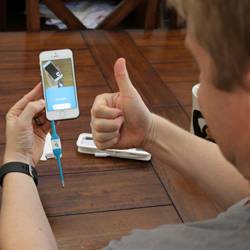
Researchers at the University of Iowa (UI) have found a way to get a jump on forecasting outbreaks of influenza-like illnesses by using real-time data from smart thermometers.
"Using simple forecasting models, we showed that thermometer data could be effectively used to predict influenza levels up to two to three weeks into the future," says Aaron Miller, an assistant professor or epidemiology at UI.
Miller's team secured its study data from Kinsa Inc., a maker of smart thermometer products. The U.S. Food and Drug Administration-approved devices plug into Android or Apple smartphones and can send anonymized fever readings to Kinsa corporate headquarters in San Francisco.
Thanks to Kinsa, Miller's team was able to study more than 8 million temperature readings from all 50 U.S. states, which were provided over a period of nearly two years.
The team found that by using real-time data from the off-the-shelf thermometers, they were able to forecast outbreaks of flu-like illness in various parts of the country up to three weeks earlier than conventional forecasting methods.
Their forecasting method represents an advance over traditional methods, which generally work with data that is up to two weeks old.
Moreover, by using direct evidence of flu-like illness symptoms as indicated by thermometer readings, Miller says the study was able to be more accurate than forecasts based on Twitter activity or Google searches. Such social media based studies, he says, are flawed in that they rely on 'talk' or 'mentions' of flu-like symptoms as flu indicators , rather than hard evidence like precise thermometer readings.
"Most of these sources represent proxy measures; searches for 'influenza' or tweets about 'flu'," Miller says. "One advantage of the smart thermometer data is that we actually measure a clinical sign strongly associated with influenza: fevers. In addition, we can obtain duration of fevers and other features such as potential in-household transmission."
Sen Pei, a postdoctoral research scientist at Columbia University who also studies flu forecasting, agrees. "The major advantage of Miller's work is that, as opposed to previously used indirect proxies, body temperature is a direct clinical marker for influenza-like Illness."
Miller said Kinsa was able to provide the data for his study because the company takes great pains to assure smart thermometer users that all data sent back to its corporate headquarters is de-identified; names, home addresses, and other individual-specific information are never included. Even so, Kinsa was able to pinpoint the location of each fever reading from the GPS location data provided by each app user's smartphone, as well as by noting the IP address of each reporting smartphone. That allowed the researchers to conclude "the vast majority of readings occurred within households," Miller says. "However, given the de-identified nature of the data we analyzed, there is no way for us to determine exact locations of use."
The team used the statistical programming language R to process and analyze the data, which was run on a MacBook Pro.
"This is a great example of overcoming a limitation of traditional disease surveillance systems: the lag between a person developing symptoms and being included in the surveillance data," says Robert Moss, a research fellow at the Center for Epidemiology and Biostatistics and the Melbourne School of Population Growth and Global Health, both at Australia's University of Melbourne.
"Another advantage is that this appears to be a cost-effective way to collect these kinds of data, as smart thermometers are relatively inexpensive," says Moss, who studies flu forecasting. Moreover, Moss says, smart thermometers could ultimately result in flu forecasting in which costs would be negligible: consumers would provide the data free via their smart thermometers, and health professionals would use already designed analysis software to interpret that data and make predictions.
Adds Wan Yang, an associate research scientist in environmental health sciences at Columbia University who studies flu forecasting, "As these data are available in near real-time, as opposed to lagging one to two weeks in traditional surveillance, they have the potential to complement traditional surveillance and provide more timely situation awareness of respiratory infections."
Still, while real-time fever readings are a good indicator of flu, but they're not perfect.
"Cautions need to be taken in the interpretation of Miller's work," says Columbia's Pei. He explains that the study's authors are forecasting "influenza-like illness, which is not exclusively defined for influenza."
In addition. Pei says he's skeptical that Miller's method can actually predict flu three weeks in advance of an actual outbreak, given that predicting the severity of a flu outbreak when it is reaching its peak is tougher to nail down.
Joe Dysart is an Internet speaker and business consultant based in Manhattan, NY, USA.



Join the Discussion (0)
Become a Member or Sign In to Post a Comment